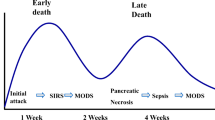Abstract
Background
A number of studies deal with factors affecting postoperative recurrence; however, they do not analyze the influence of postoperative morbidity on the long-term outcome. This was the aim of the present study.
Materials and methods
Two hundred eighty-two patients underwent 331 intestinal resections for primary or recurrent Crohn’s disease between 1992 and 2005. Closure of ileostomy or colostomy, isolated stricturoplasty, abdominoperineal resection for perianal disease, and reoperations for postoperative complications were excluded. “Surgical recurrence” was defined as a development of stricturing or perforating disease necessitating repeat surgical therapy.
Results
Anastomotic leak, intraabdominal abscess, enterocutaneous fistula (intraabdominal septic complications, IASC) occurred after 46 operations (16%). Four patients died (1.2%). By multivariate analysis, articular disease manifestation (p = 0.03), duration of symptoms leading to surgery (p = 0.009), and weight loss (p = 0.03) were associated with occurrence of postoperative complications. Surgical recurrence occurred following 86 bowel resections, and 36 occurred during the first postoperative year. The following factors were associated with an increased risk of surgical recurrence by multivariate analysis: postoperative IASC (p = 0.0002) and previous bowel resections (p = 0.002). Patients suffering IASC had statistically significantly higher 1-, 2-, 5-, and 10-year surgical recurrence rate (25%, 29%, 50%, and 57%) than patients without IASC (4%, 7%, 19%, and 38%, p = 0.0003).
Conclusion
The incidence of the postoperative IASC is predominantly determined by preoperative disease severity. IASC have a detrimental influence on the long-term outcome following intestinal resections in patients with Crohn’s disease, leading to increased number of repeat resection surgery.

Similar content being viewed by others
References
Olaison G, Sjödahl R, Tagesson C (1990) Glucocorticoid treatment in ileal Crohn’s disease: relief of symptoms but not of endoscopically viewed inflammation. Gut 31:325–328
Dietz DW, Laureti S, Strong SA et al (2001) Safety and longterm efficacy of strictureplasty in 314 patients with obstructing small bowel Crohn’s disease. J Am Coll Surg 192:330–337
Tay GS, Binion DG, Eastwood D et al (2003) Multivariate analysis suggests improved perioperative outcome in Crohn’s disease patients receiving immunomodulator therapy after segmental resection and/or strictureplasty. Surgery 134:565–572
Yamamoto T, Allan RN, Keighley MR (2000) Risk factors for intra-abdominal sepsis after surgery in Crohn’s disease. Dis Colon Rectum 43:1141–1145
Penner RM, Madsen KL, Fedorak RN (2005) Postoperative Crohn’s disease. Inflamm Bowel Dis 11:765–777
Landsend E, Johnson E, Johannessen HO et al (2006) Long-term outcome after intestinal resection for Crohn’s disease. Scand J Gastroenterol 41:1204–1208
Yamamoto T (2005) Factors affecting recurrence after surgery for Crohn’s disease. World J Gastroenterol 11:3971–3979
Holzheimer RG, Molloy RG, Wittmann DH (1995) Postoperative complications predict recurrence of Crohn’s disease. Eur J Surg 161:129–135
Caprilli R, Gassull MA, Escher JC, European Crohn’s and Colitis Organisation et al (2006) European evidence based consensus on the diagnosis and management of Crohn’s disease: special situations. Gut 55(Suppl 1):36–58
Alves A, Panis Y, Bouhnik Y et al (2007) Risk factors for intra-abdominal septic complications after a first ileocecal resection for Crohn’s disease: a multivariate analysis in 161 consecutive patients. Dis Colon Rectum 50:331–336
Bruewer M, Utech M, Rijcken EJ et al (2003) Preoperative steroid administration: effect on morbidity among patients undergoing bowel resection for Crohn’s disease. World J Surg 27:1306–1310
Post S, Betzler M, von Ditfurth B et al (1991) Risks of intestinal anastomoses in Crohn’s disease. Ann Surg 213:37–42
Heimann TM, Greenstein AJ, Mechanic L et al (1985) Early complications following surgical treatment for Crohn’s disease. Ann Surg 201:494–498
Bissett IP (2007) Ileocolic anastomosis. Br J Surg 94:1447–1448
Simillis C, Purkayastha S, Yamamoto T et al (2007) A meta-analysis comparing conventional end-to-end anastomosis vs. other anastomotic configurations after resection in Crohn’s disease. Dis Colon Rectum 50:1674–1687
Smedh K, Andersson M, Johansson H et al (2002) Preoperative management is more important than choice of sutured or stapled anastomosis in Crohn’s disease. Eur J Surg 168:154–157
Waitzberg DL, Saito H, Plank LD et al (2006) Postsurgical infections are reduced with specialized nutrition support. World J Surg 30:1592–1604
Colombel JF, Loftus EV Jr, Tremaine WJ et al (2004) Early postoperative complications are not increased in patients with Crohn’s disease treated perioperatively with infliximab or immunosuppressive therapy. Am J Gastroenterol 99:878–883
Pearson DC, May GR, Fick GH et al (1995) Azathioprine and 6-mercaptopurine in Crohn disease. A meta-analysis. Ann Intern Med 123:132–142
Sandborn WJ (1997) Preliminary report on the use of oral tacrolimus (FK506) in the treatment of complicated proximal small bowel and fistulizing Crohn’s disease. Am J Gastroenterol 92:876–879
Feagan BG, Rochon J, Fedorak RN, The North American Crohn’s Study Group et al (1995) Investigators Methotrexate for the treatment of Crohn’s disease. N Engl J Med 332:292–297
Greenberg GR, Feagan BG, Martin F, Canadian Inflammatory Bowel Disease Study Group et al (1994) Oral budesonide for active Crohn’s disease. N Engl J Med 331:836–841
Present DH, Rutgeerts P, Targan S et al (1999) Infliximab for the treatment of fistulas in patients with Crohn’s disease. N Engl J Med 340:1398–1405
Williams AJ, Palmer KR (1991) Endoscopic balloon dilatation as a therapeutic option in the management of intestinal strictures resulting from Crohn’s disease. Br J Surg 78:453–454
Cosnes J, Nion-Larmurier I, Beaugerie L et al (2005) Impact of the increasing use of immunosuppressants in Crohn’s disease on the need for intestinal surgery. Gut 54:237–241
Fichera A, Peng SL, Elisseou NM et al (2007) Laparoscopy or conventional open surgery for patients with ileocolonic Crohn’s disease? A prospective study. Surgery 142:566–571
Alves A, Panis Y, Bouhnik Y et al (2005) Factors that predict conversion in 69 consecutive patients undergoing laparoscopic ileocecal resection for Crohn’s disease: a prospective study. Dis Colon Rectum 48:2302–2308
Hildebrandt U, Pistorius G, Lindemann W et al (1995) Laparoscopic resections in Crohn disease. Chirurg 66:807–812
Author information
Authors and Affiliations
Corresponding author
Rights and permissions
About this article
Cite this article
Iesalnieks, I., Kilger, A., Glaß, H. et al. Intraabdominal septic complications following bowel resection for Crohn’s disease: detrimental influence on long-term outcome. Int J Colorectal Dis 23, 1167–1174 (2008). https://doi.org/10.1007/s00384-008-0534-9
Accepted:
Published:
Issue Date:
DOI: https://doi.org/10.1007/s00384-008-0534-9




